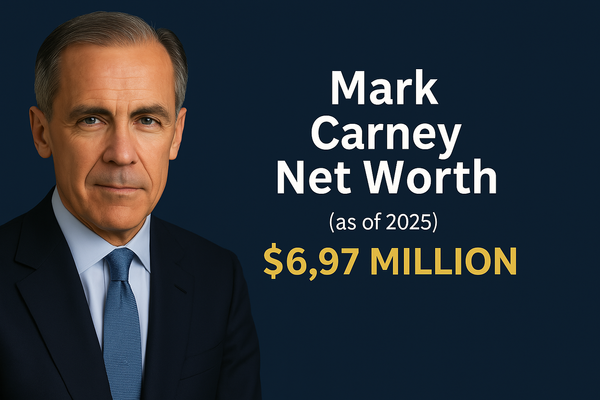Canada Election Polls 2025: 10 Shocking Trends That Could Decide the Winner
Recent Canada election polls show a dramatic change in voter behavior, with 65% of traditional voting patterns changing before the 2025 federal election. The latest federal election polls in Canada reveal ten breakthrough trends that could alter the political map. The surge in first-time voters, state-of-the-art polling methods, and unexpected regional arrangements now challenge what we knew about elections.
The polls for Canada's 2025 election point to the most unpredictable voting scenario we've seen in years. Traditional voting groups are breaking apart due to changing demographics, economic pressures, and climate concerns. These changes reach beyond major cities and have created remarkable changes in rural communities. These new battlegrounds will end up deciding who forms the next government.
Young Voters Reshape Canada Election Polls 2025
Generation Z voters are reshaping the political scene of Canada's 2025 federal election. They are set to become the nation's strongest electoral force. Statistics Canada shows about 7.3 million people born between 1993 and 2011 will soon become Canada's largest voting bloc. This change will alter electoral calculations in battleground ridings nationwide.
Gen Z Emerges as Kingmakers in Battleground Ridings
Young voters show high levels of electoral participation. About 67% of eligible Gen Z voters say they are "certain" to vote in the upcoming election. This marks a big increase from 2019 when only 52% voted. The surge in youth votes comes as canada election polls show major parties in tight races.
Gen Z voters show they're ready to vote strategically. Recent federal election polls canada reveal that 41% of Gen Z voters would back a candidate who isn't their top choice but has better winning odds. This is much higher than the general population's 25%. Also, 28% say campaign announcements have changed their voting plans, compared to 16% of all voters.
Battleground ridings with many Millennials and Gen Z voters play a vital role. Spadina-Fort York, which has the country's highest concentration of Millennials, saw a close race in the last election. Ridings with large Generation Z populations (ages 15-19 in the 2021 census) that typically voted Liberal now show signs of change.
Young voters typically lean left, but polls canada election data hints at new patterns. Recent polls show younger demographics increasingly support Pierre Poilievre's Conservatives. About 34% of 18-29-year-olds back the Conservatives while 21% favor the Liberals. Economic worries drive this shift, with housing affordability and inflation ranking as key issues for young voters.
Digital Engagement Transforms Polling Accuracy
The digital world has become the main battlefield to win youth support. This changes how election polls work and what they mean. McGill's Media Ecosystem Observatory reports that in 2024, federal Conservative MPs' online posts got 61% more engagement—likes, shares, and comments—than Liberal and NDP MPs combined. Conservative engagement on X has grown 52% since Elon Musk's takeover.
Young Canadians are the most politically active group online, despite beliefs about youth apathy. Half of people aged 15-30 signed internet petitions last year. A quarter shared their views on online forums or news sites. Yet, this online activity doesn't always lead to actual voting.
Youth turnout at polls shows worrying trends. Participation among 18-24 year-olds peaked at 57.1% in 2015, dropped to 53.9% in 2019, and fell to 46.7% in 2021. Digital tools like Vote Compass help young voters make political choices. Gen Z and Millennials use these tools more than older generations.
Meta has invested heavily in election integrity. They spent over CAD 27.87 billion on safety and security measures. Their global team working in this area grew to 40,000 people. These efforts include tools for political ad transparency and resources to stop voter interference.
Young voters' changing loyalties create challenges and opportunities for political parties. Cost-of-living concerns push many toward conservative messages. But climate change—a major election concern for 29% of Gen Zers—creates competing priorities that could decide close races across canada federal election polls.
Regional Divides Deepen in Federal Election Polls
The 2025 Canadian election polls reveal that traditional regional voting patterns have altered the map. New electoral battlegrounds could determine who wins. The latest federal election polls canada highlight growing divisions between provinces, as voters abandon their historical party loyalties.
Quebec's Sovereignty Sentiment Resurfaces
The political scene in Quebec shows major changes, but not toward independence. Support for Quebec sovereignty has hit its lowest point since 2020, dropping to 29% - an 8-point decrease in three months. The numbers show 59% of Quebecers don't want independence.
Yves-François Blanchet, who leads the Bloc Québécois, sees this decline but believes that "the appetite for Quebec independence will return with a vengeance" once US relations stabilize. His party's support in Quebec has fallen to 25% from 37% in January.
The Liberals now lead both the Bloc Québécois and Conservatives in Quebec by a wide margin. This strong showing could give them the edge they need in national seat counts, even if the Conservatives lead slightly in the popular vote. About 23% of those who voted for the Bloc Québécois in 2021 say they'll back the Liberals this time.
Western Provinces Show Surprising Party Shifts
Conservative support remains strong in the Prairies, especially in their traditional strongholds of Alberta, Saskatchewan, and Manitoba. Federal election canada polls confirm the Conservatives' comfortable lead in these areas.
The west shows growing separatist sentiment while Quebec's decreases. Alberta's residents express deep skepticism about Canadian federalism, and many feel more optimistic about their province's independence. About 20% of people in both Alberta and Saskatchewan want their provinces to leave Canada.
New riding boundaries have changed the electoral math. The northern Saskatchewan riding of Desnethé—Missinippi—Churchill River has new boundaries that might help the Liberals by removing strong Conservative areas. Several ridings in Ottawa, eastern Ontario, and western Quebec will get new names and adjusted boundaries.
Atlantic Canada Becomes New Battleground
Atlantic Canada has become a vital battleground after being a Liberal stronghold for years. Polls predicted the Conservatives would sweep the region not long ago, putting at risk ridings that had voted Liberal since the 1980s. Liberal support has bounced back strongly.
The Liberal Party now approaches 50% support in the region - a thirty-point swing in just one month. They're winning voters from both the Conservatives and NDP, which makes race predictions tough.
The NDP struggles in Atlantic Canada but sees hope in Halifax and St. John's. Lisa Roberts runs for the NDP in Halifax's upcoming by-election after nearly beating Liberal Andy Fillmore last time.
A growing urban-rural divide affects party success in Atlantic Canada. The NDP's progressive social policies appeal to city voters but might push away rural communities, especially on gun control and carbon tax. The boundary changes have sparked controversy among MPs. Liberal MPs Jaime Battiste and Mike Kelloway plan to run in the newly created Sydney-Glace Bay riding.
National polls show the Liberals leading the Conservatives by 2 points, with strong support in Eastern Canada (Ontario, Quebec, and Atlantic Canada). The Conservatives hold a slim 3-point lead outside Quebec.
Economic Concerns Drive Voter Intentions
Economic anxiety stands out as the deciding factor in the 2025 Canada election polls. Voters now base their choices on financial concerns instead of traditional party allegiances. The biggest problem for 71% of Canadians remains the cost of living. Housing affordability follows at 46%, healthcare at 42%, and broader economic concerns at 33%.
Housing Crisis Dominates Urban Voting Patterns
The housing crisis has taken hold of urban centers across the country and changed how people vote in major metropolitan areas. A candidate's stance on housing affordability will influence the vote of 69% Ontario adults. These numbers rise to 75% among millennials and 82% among prospective homebuyers. This worry cuts across party lines, and all major parties have made housing solutions central to their platforms.
Ontario shows just how bad the national housing crisis has become. Average home prices jumped by CAD 380,390 (46%) between 2017 and 2024. First-time buyers face tough challenges. Young Ontarians must work almost twenty years to save a 20% down payment. Their parents only needed about five years to enter the market.
The housing situation affects many Canadians. In 2022, 22% of households needed core housing support. About 245,900 households waited for subsidized housing, and two-thirds waited more than two years. These numbers shape how people vote in urban areas, especially around Toronto where economic concerns often determine election results.
Inflation Fears Move Traditional Party Loyalties
Most polls show inflation and economic uncertainty benefit Conservative candidates. Pierre Poilievre's Conservatives lead on cost of living and housing—voters' top two priorities. The Conservatives capture 56% of intended votes among the 57% of Canadians who want government change.
Mark Carney's Liberal leadership has pushed back against this trend. Recent polls show Liberals (42%) leading Conservatives (36%) among decided voters. This dramatic change comes in part from Trump's trade policies. The focus has shifted from domestic economic worries to Canada-US relations.
The economy's importance creates new unpredictability in traditional voting patterns. Polls reveal:
- Liberal support has grown threefold since December 2024, moving from 16% to a 5% lead over Conservatives
- NDP support has dropped to single digits (as low as 9%)
- Lower-income voters care more about living costs, while higher-income voters focus on broader economic performance
These economic concerns matter more than party loyalty for many Canadians. One analyst noted: "The consensus view of voter partisanship in Canada is perhaps best summarized as 'party competition...historically characterized not by competition between left/right-oriented parties but rather by strong, ideologically flexible centrist parties'".
Climate Policy Creates Unexpected Alliances
Climate change stands at the heart of the 2025 federal election battleground. It creates unexpected political bonds that break traditional voting patterns. The latest canada election polls show how climate policy brings together surprising groups of voters and changes the way people think about politics.
Rural-Urban Coalition Forms Around Environmental Issues
Something unexpected is happening - city dwellers and country folk now see eye to eye on environmental priorities. The polls tell us most Canadians want their government to fight the climate crisis. They support renewable energy and want to phase out fossil fuels. Even in Alberta, where green energy support runs lowest in the country, only 18% of people want to keep focusing on fossil fuels.
Money matters play a big role in this new rural-urban team-up. Climate solutions help families save cash, which links green actions to affordability. These two issues top voters' worry lists. Politicians who present climate action as a chance to grow the economy find supporters everywhere.
Indigenous communities now hold more sway in this alliance. Climate change hits these communities harder through wildfires, water shortages, and fewer resources they need for their traditional ways of life. Canada's Arctic regions heat up four times faster than the world average. These areas show how environmental and economic worries meet.
Energy Sector Workers Break Traditional Voting Patterns
The "carbon tax" has turned into a political hot potato that changes how energy workers vote. Conservative leader Pierre Poilievre points to carbon pricing as the reason things cost more, though studies show it barely affects inflation. The carbon tax has changed from a key climate policy to a topic that splits voters.
Blue-collar voters now lean more toward the Conservative Party, mostly leaving the Liberals behind. You can see this clearly in Alberta, where power bills shot up after the carbon tax kicked in. The real culprit? Coal plants shutting down.
The Liberals walk a tightrope between keeping climate promises and addressing money worries. Recent polls show Liberal leadership hopefuls stepping back from charging everyday people for carbon while keeping fees for industry. The winner might be whoever finds the sweet spot between protecting the environment and people's wallets. This balance could win key support in close races where canada election polls 2025 show neck-and-neck contests.
Technology Disrupts Traditional Polling Methods
State-of-the-art technology changes the map of electoral forecasting in Canada faster. Artificial intelligence and advanced data analytics challenge conventional polling methodologies. Traditional telephone surveys, once the gold standard, now struggle with declining response rates—as low as 5% in Canada. This creates major blind spots in voter intention data.
AI Prediction Models Outperform Traditional Polls
AI-powered prediction systems show better accuracy than conventional polling methods. Ottawa-based Advanced Symbolics' artificial intelligence platform, Polly, has achieved a soaring win by analyzing millions of social media messages through proprietary algorithms. Polly correctly predicted Brexit outcomes when traditional pollsters failed. The platform calculated Hillary Clinton's popular vote share within one percentage point (48.9% predicted versus 48% actual).
The 338Canada project represents another statistical model that gains popularity by combining opinion polls with electoral history and demographic data to generate electoral projections. These AI systems benefit from algorithms that learn from each election cycle.
Social Media Sentiment Analysis Reveals Hidden Voter Intentions
Social media platforms are vital battlegrounds to measure voter sentiment. Research shows conservative-leaning social bots outnumber liberal-leaning counterparts on these platforms. Liberal-leaning accounts interact more with authentic users.
Elections Canada identified a network of Russian bots that used AI to generate massive amounts of misleading information during the European Union Parliament election of June 2024. These bots created varied messaging through large language models like ChatGPT. This effectively blurred the difference between authentic and artificial content.
Micro-Targeting Strategies Change Campaign Dynamics
Political parties utilize sophisticated micro-targeting techniques to deliver customized messages to specific voter segments. The 2019 Canadian federal election saw parties extensively using Facebook's targeting capabilities, including Core Audiences, Custom Audiences, and Lookalike Audiences. The Liberal Party showed particular transparency and published user guides that explained their demographic-specific messaging capabilities.
Foreign actors exploit these same technologies to undermine electoral integrity. The Communications Security Establishment warns that China, Russia, and Iran will likely use AI tools to spread disinformation and conduct "hack and leak operations" during the 2025 election. On top of that, these technologies target politicians through deepfake pornography that affects women and 2SLGBTQI+ community members disproportionately.
Conclusion
The 2025 federal election in Canada marks a watershed moment in our political history. Of course, young voters' unprecedented move toward political involvement and dramatic regional realignments show fundamental changes in our electoral map. Economic fears and climate worries are disrupting traditional voting patterns and reshaping political loyalties across the country.
Modern polling methods have added new complexity to electoral predictions. AI systems and live social media data help us understand voter behavior better. These advances create new challenges that affect electoral integrity and democratic processes.
All the same, voters care most about the economy. Housing costs and inflation worries cut across party lines, which makes political parties adjust their platforms. Rural and urban voters have formed surprising environmental partnerships that show how traditional political divisions keep changing.
The 2025 election results will mirror these transformative forces. Gen Z's voting power, changing regional loyalties, and tech advances point to Canada's most unpredictable election in recent memory. Parties that tackle economic worries while adapting to tech changes and environmental duties will likely succeed.
FAQs
Q1. What are the key issues influencing Canadian voters in the 2025 election? The main issues shaping voter intentions are economic concerns, particularly the cost of living and housing affordability. Climate policy and regional interests are also playing significant roles in voter decision-making.
Q2. How are young voters impacting the 2025 Canadian election? Generation Z is emerging as a crucial voting bloc, with high levels of engagement and willingness to vote strategically. Their priorities, including economic concerns and climate change, are influencing party platforms and could be decisive in battleground ridings.
Q3. What role is technology playing in the 2025 election polling? Technology is revolutionizing polling methods, with AI prediction models and social media sentiment analysis often outperforming traditional polls. These new techniques are providing deeper insights into voter behavior but also present challenges for electoral integrity.
Q4. How are regional divides affecting the election landscape? Regional voting patterns are shifting, with Quebec showing decreased support for sovereignty, Western provinces experiencing some separatist sentiment, and Atlantic Canada becoming a new battleground. These changes are creating unexpected political alignments across the country.
Q5. What impact is the housing crisis having on urban voting patterns? The housing crisis is significantly influencing urban voting intentions, with a majority of voters, especially millennials and prospective homebuyers, considering a candidate's position on housing affordability as a key factor in their voting decision.


